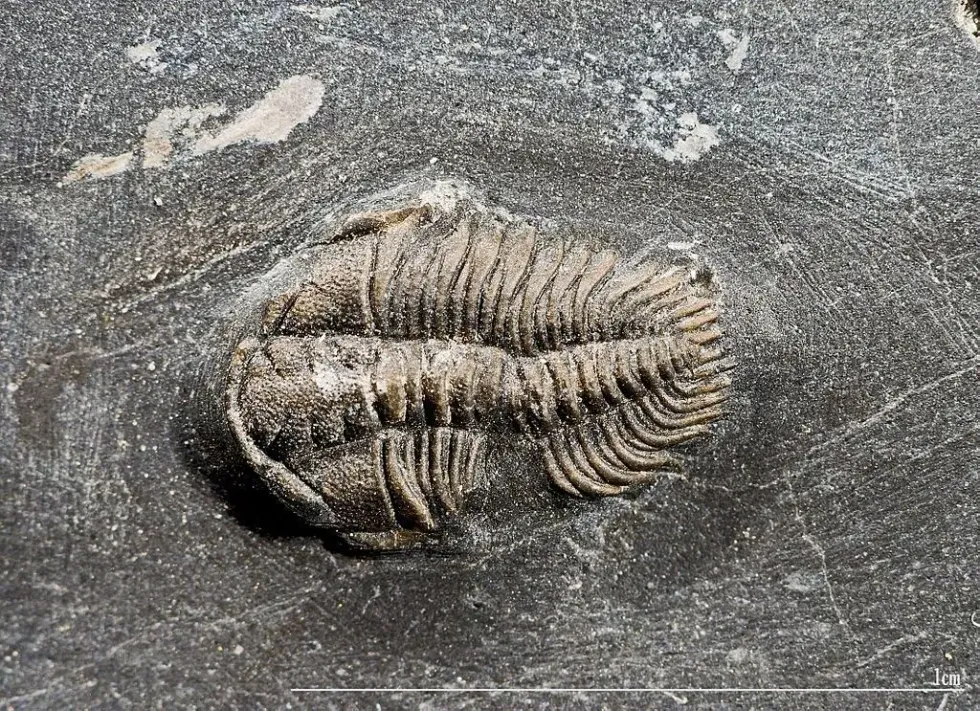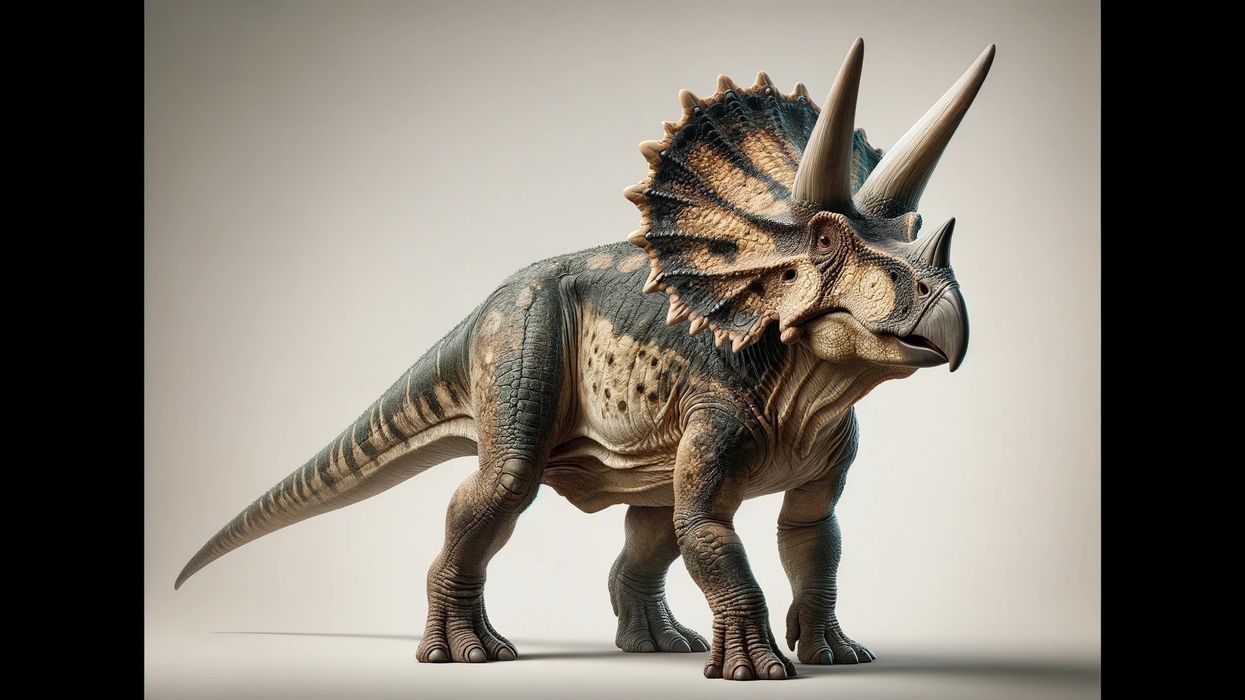Trilobites were marine arthropods that existed over 300 million years ago in the depths of the ocean across the world. They first appeared in the Pre Cambrian era and quickly grew to form the most diverse species in the world, with over 20,000 subspecies and 10 different orders.
They lived for 300-400 million years, surviving major mass extinction events such as the End Devonian extinction event and the End Ordovician extinction event. They were characterized by their small rounded bodies, shiny spines, a hard exoskeleton, and a single pair of complex eyes with many lenses.
In fact, they were the first lifeforms that developed complex eyes with multiple lenses.
These lenses were crystal lenses. These marine arthropods went extinct 11 million years before the evolution of the human race.
Read further for more trilobite fossil facts, and do check out our woodlouse facts and golden tortoise beetle facts pages!
Trilobite Interesting Facts
What type of animal is a trilobite?
The Trilobite is an ancient aquatic arthropod of the class Trilobita. Living relatives include the horseshoe crab and the Scorpion.
What class of animal does a trilobite belong to?
The Trilobite is an arthropod.
How many trilobites are there in the world?
Trilobites are extinct. This means that there are no living members of this species in the world today.
Where does a trilobite live?
Trilobites are aquatic arthropods which means that they lived in the sea. They were very widespread and trilobite fossils were found in the Pacific, Indian, Atlantic, and Arctic Oceans.
They were considered to be the most diverse and widely distributed lifeforms on the planet, with over 10 different orders and 20,000 different subspecies. Other animals that are found in every continent include the river otter and the dung beetle.
What is a trilobite's habitat?
Trilobites are marine creatures. This means that their main habitat is the water.
They were found in deep seas, on the sea beds, in the open ocean, in shallow waters and rivers. They lived over 250 million years ago when the oceans were far more widespread than we know them today. Hence, Trilobite fossils can be found across the world on almost every continent.
Who do trilobites live with?
It is not known if trilobites used to live in strict groups that hunted together. However, there were different groups of trilobites all over the world known for their individual habitats, feeding habits, and physical characteristics.
How long do trilobites live?
The exact lifespan of the Trilobite is not known. However, it is estimated that different species of trilobites lived for over 300 million years, surviving major extinction events that wiped out almost every other species.
How do they reproduce?
The exact reproduction habits of trilobites are unknown. However, based on other similar arthropods that are alive today, it can be assumed that trilobites reproduced oviparously, which means that they reproduced by means of eggs.
What is their conservation status?
Trilobites have been classified as Extinct by the IUCN. They were killed 11 million years before the evolution of the first human ancestor. Their fossils have been discovered all over the world.
Trilobite Fun Facts
What do trilobites look like?
The trilobite has often been likened to crabs in terms of their appearance. The trilobite is covered by a hard exoskeleton, and they have three major lobes on their body.
These lobes are known as the left pleural lobe, the middle axial lobe, and the right pleural lobe. They are further divided into three main body parts or segments in addition to these lobes, the Cephalon or the head, the thorax or the midsection, and the Pygidium or the tail.
The thick exoskeleton protected these trilobites from any external harm. They also had many spines and long tails.
There were over 20,000 species of trilobites with different physical characteristics. For example, the trilobites that lived in the depths of the sea often had no eyes, as they were at depths where there was no light.

How cute are they?
Trilobites were not cute. They bear some resemblance to crabs and bugs with their spines and hard exoskeletons. However, many of them had beautiful long, shiny spines and exoskeletons.
How do they communicate?
The method of communication between the various trilobite species is unknown as they existed over 250 million years ago. However, from the habits of other closely related arthropods, it can be assumed that the trilobite used a combination of chemical signatures and vibrations to communicate and locate its prey.
How big is a trilobite?
Trilobites can grow anywhere between 0.03-2.8 in (1-72 mm). The smallest trilobite fossil that was found was the Acanthopleurella stipulae, which was a maximum length of 1 mm. The largest trilobite fossil found was the Isotelus rex, which was a maximum length of 2 ft (60.9 cm).
How fast can trilobites move?
The exact speed of the trilobite is not known. However, due to the rounded shape and small size of its body, it can be assumed that the trilobite could move very quickly in the water.
How much does a rrilobite weigh?
The exact weight of a trilobite is unknown. However, based on the fossils discovered, we know that trilobites grew to lengths between 0.03-2.8 in (1-72mm).
What are the male and female names of the species?
There are no specific names for male and female trilobites. They are simply referred to as male trilobites or female trilobites.
What would you call a baby trilobite?
There are no specific names for baby trilobites.
What do they eat?
Trilobites were omnivores, and often ate a combination of plants, insects, and worms such as plankton, worms, diatoms, fish, algae, aquatic plants. Some trilobite species, however, were strictly herbivorous.
Are they harmful?
No, trilobites were not harmful species. They were a small, aquatic species that used to dwell in the depths of the ocean. However, they were extremely adaptable as they survived multiple major extinction events (such as the Cambrian explosion) before their own extinction at the end of the Paleozoic period.
Would they make a good pet?
No, trilobites would not make good pets. There are no living trilobites in the world today. In addition to this, they are not cute, and they require large depths and ocean habitats.
Did you know...
Since these arthropods first appeared in the Pre Cambrian period, they quickly spread across the world, becoming the most diverse species to exist on this planet. They lived for over 300 million years, making them one of the oldest arthropods to exist on the planet.
They developed a very hard and tough exoskeleton which protected them from extinction and helped them survive for millions of years. They could roll themselves to form a ball, protecting them from harm.
These exoskeletons also acted as a heat shields and body shields. In addition to this, even well after their extinction, these exoskeletons survived and were discovered as fossils in recent times.
Trilobites were the first animals to have developed eyes. A large number of trilobite species developed eyes that consisted of many crystal lenses. However, the trilobites that lived in the bottom of the ocean often did not develop eyes because they were at depths where there was no light from the surface.
Trilobites could undergo a process known as molting, which means that as they grew, they would molt or shed their exoskeleton. This would leave them exposed and soft. A large majority of the trilobite fossils found today are just these molted or shredded exoskeletons.
What killed the trilobites?
The trilobites came into existence in the Pre Cambrian age. A large number of trilobite fossils discovered were from the Cambrian period.
Since their origin, trilobites have seen many mass extinction events that killed many animals. Extinction events such as the Ordovician extinction event killed a large number of trilobites. Following this, the End Devonian extinction event killed all the remaining orders of trilobites except for a single one.
These trilobites survived until the Great Permian extinction event in the Paleozoic age, which killed the very last order of trilobites. However, due to their hard and strong exoskeleton, these trilobites were fossilized and these fossils allowed scientists to research and discover this species.
Trilobites developed an exoskeleton with segments during the Cambrian period to allow them to enroll themselves into a ball to protect themselves from harm. These segments were divided into the Cephalon (the head region), the thorax (the midsection region), and the pygidium (the tail region).
What is special about trilobites?
Trilobites were the most diverse species to exist on this planet. Since they first appeared in the Pre-Cambrian period, these trilobites spread throughout the planet, forming 10 different orders and 20,000 different subspecies. They were also the most widely distributed species, with trilobite fossils from the Cambrian period and after being found on every single continent on the planet.
In addition to this, the trilobites survived multiple mass extinction events that wiped out many other species. These mass extinction events included the End Ordovician extinction event and the End Devonian extinction event.
Here at Kidadl, we have carefully created lots of interesting family friendly animal facts for everyone to discover! For more relatable content, check out these Eastern Hercules beetle facts, or dragonfly facts pages.
You can even occupy yourself at home by coloring in one of our free printable I for insect coloring pages.









